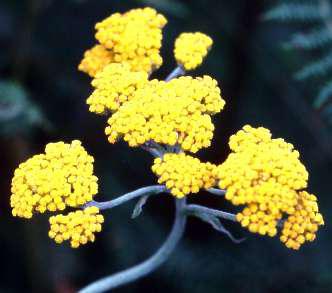Helichrysum odoratissimum
Helichrysum odoratissimum (L.) Sweet.
Family: Asteraceae
Common names: most fragrant helichrysum (Eng.); kooigoed, kruie (Afr.); imphepho (Xhosa & Zulu)
Introduction
As its name implies, this plant has a strong smell. It is widely used as a perfume, but also as an insect repellent.

Description
Description
Helichrysum odoratissimum is a strongly aromatic, much branched perennial herb with small silvery leaves and small yellow flowerheads borne in groups at the tips of the branches; woody at the base, erect or diffuse, up to 50 cm high.

Leaves vary from linear-oblong, lanceolate, lingulate to spathulate, markedly decurrent, apex generally obtuse, sometimes acute, mucronate, base narrow or broad, glandular and setose-scabrid above, greyish-white, wooly on both surfaces, sometimes without wool. Capitula in crowded, compound inflorescence at the end of a naked peduncle. Involucral bracts obtuse, outermost wooly, inner brown and the innermost bright yellow. Bracts on the receptacle pointed, tooth-like, slightly longer the ovary. Fruit dull brown, granular.
Flowers throughout the year, but in the south-western Cape mainly from August to December, and from January to June elsewhere.
Distribution and habitat
Distribution description
This plant ranges from the Soutpansberg in Limpopo through the highlands of the Mpumalanga and W. Swaziland to the Midlands and Uplands of KwaZulu-Natal, the NE. Free State, Lesotho, the Cape Drakensberg, mountains and coastal areas of Eastern Cape, across the Cape folds mountains of Cedarberg, Giftberg in Vanrhynsdorp as far as Peninsula in the Western Cape. Also on the mountains of Mozambique, Zimbabwe, Malawi and further north.
It forms large clumps in grassy or rocky slopes and will colonize bare areas such as roadsides and paths.
Derivation of name and historical aspects
History
The genus name, Helichrysum, refers to the golden yellow flowers and comes from the Greek words helios meaning sun and chrysos meaning gold. The specific epiphet odoratissimum refers to the strong fragrance of this particular species. Many other species of the genus are also aromatic.
Helichrysum has 600 species largely in Africa, Madagascar, also in Europe, Asia and Australia, 244 species occuring in southern Africa where they are widely distributed.
Uses
Use
Several species of Helichrysum are used in traditional medicines, but H. odoratissimum is widely used as a perfume and to repel insects. Southern Sotho women make a perfumed ointment from this plant.
Leaves and stems are widely used as incense to invoke the goodwill of the ancestors; the smoke is sedative and helpful for insomnia. In the Eastern Cape people inhale it as a protective cleanser and it is also used medicinally for coughs and colds. Some people boil the plant and use it as a facial ointment for pimples. In Lesotho they burn this plant to fumigate sick rooms. It is also effective in repelling parasites and insects thus ensuring a good night's rest.
Several species make good garden plants.
Growing Helichrysum odoratissimum
Grow
Propagation is by seed and stem cuttings. Set this aromatic plant out in groups of 3-5 or mass plant in a sunny position, to form a superb and dazzling ground cover, especially when in flower. It is perfect for the new garden where it will provide colour while slower shrubs are establishing themselves. The soil must be light and well-drained and be well-composted. Do not overwater, especially in winter, as helichrysums tend to become infected with fungus. Regard this plant as temporary and replace it every 2-3 years.
References
- Adamson, R.S. & Salter, T.M. 1950 Flora of the Cape Peninsula. Juta & C.O. Ltd. Cape Town and Johannesburg.
- Arnold, T.H. & De Wet, B.C. 1993. Plants of southern Africa: names and distribution. Memoirs of the Botanical Survey of South Africa No. 62.
- Germishuizen G & Meyer NL, 2003, Plants of Southern Africa, Strelitzia 14, Pretoria, National Botanical Institute
- Goldblatt, P and Manning, J. 2000. Cape Plants, A conspectus of the Cape Flora of South Africa, Strelitzia 9. NBI and MBG Press, Pretoria and St Louis.
- Hilliard, O.M., 1983. Flora of Southern Africa Vol 33. Part 7. Fasc.2
- Hutchings, A., Scott, A.H., Lewis, G. & Cunningham, A.B. 1996. Zulu medicinal plants: an inventory. University of Natal Press, Pietermaritzburg.
- Joffe, P. 2003. Easy Guide to Indigenous Shrubs. Briza Publications, Singapore.
- Smith, C.A. 1966 Common Names of South African Plants. Dept. of Agricultural Technical Services, Botanical Survey Memoir No 35, Government Printer.
- Van Wyk, B-E. & Gericke, N. 2000. People's plants. A guide to useful plants of southern Africa. Briza Publications, Pretoria.
- Van Wyk, B-E., Van Oudtshoorn, B. & Gericke, N. 1997. Medicinal plants of South Africa. Briza Publications, Pretoria.
Credits
Nonkululeko Swelankomo
National Herbarium, Pretoria
December 2004
Plant Attributes:
Plant Type: Perennial
SA Distribution: Eastern Cape, Free State, KwaZulu-Natal, Limpopo, Mpumalanga, Western Cape
Soil type: Sandy
Flowering season: Sporadic/All year
PH:
Flower colour: Yellow
Aspect: Full Sun
Gardening skill: Easy
Special Features:
Horticultural zones











Rate this article
Article well written and informative
Rate this plant
Is this an interesting plant?
Login to add your Comment
Back to topNot registered yet? Click here to register.